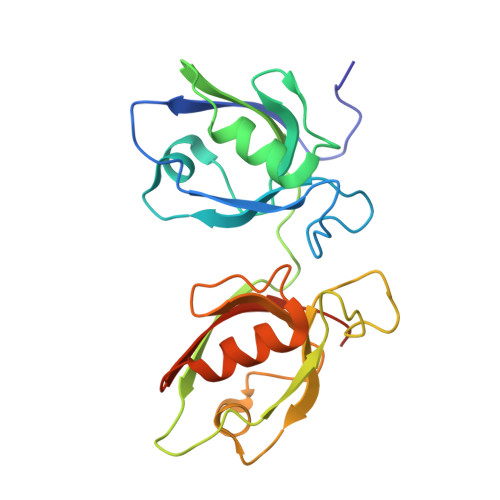Interdomain interface-mediated target recognition by the Scribble PDZ34 supramodule.
Ren, J., Feng, L., Bai, Y., Pei, H., Yuan, Z., Feng, W.(2015) Biochem J 468: 133-144
- PubMed: 25734361
- DOI: https://doi.org/10.1042/BJ20141473
- Primary Citation of Related Structures:
4WYT, 4WYU - PubMed Abstract:
Tandem-arranged PDZ [PSD-95 (postsynaptic density-95), Dlg (discs large homologue) and ZO-1 (zonula occludens-1)] domains often form structural and functional supramodules with distinct target-binding properties. In the present study, we found that the two PDZ domains within the PDZ34 tandem of Scribble, a cell polarity regulator, tightly pack in a 'front-to-back' mode to form a compact supramodule. Although PDZ4 contains a distorted αB/βB pocket, the attachment of PDZ4 to PDZ3 generates an unexpected interdomain pocket that is adjacent to and integrates with the canonical αB/βB pocket of PDZ3 to form an expanded target-binding groove. The structure of the PDZ34-target peptide complex further demonstrated that the peptide binds to this expanded target-binding groove with its upstream residues anchoring into the interdomain pocket directly. Mutations of the interdomain pocket and disruptions of the PDZ34 supramodule both interfere with its target-binding capacity. Therefore, the interdomain interface between the PDZ34 supramodule is intrinsically required for its target recognition and determines its target-binding specificity. This interdomain interface-mediated specific recognition may represent a novel mode of target recognition and would broaden the target-binding versatility for PDZ supramodules. The supramodular nature and target recognition mode of the PDZ34 tandem found in the present study would also help to identify the new binding partners of Scribble and thus may direct further research on the PDZ domain-mediated assembly of Scribble polarity complexes.
Organizational Affiliation:
*National Laboratory of Biomacromolecules, Institute of Biophysics, Chinese Academy of Sciences, 15 Datun Road, Beijing 100101, China.















